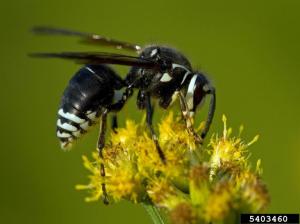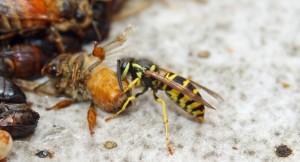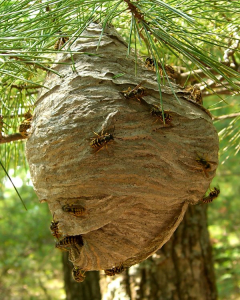Texas A&M AgriLife Extension – Paper Wasps, Yellowjackets, and Solitary Wasps
Yellowjacket
Vespula spp.
Identification
Yellowjackets are frequently mistaken for honey bees, however there are certain characteristics that can distinguish between the two. All yellowjacket species have black and yellow markings and their variations in patterns can determine the specific species. They are similar in size to honey bees (about ½ inch in length), but they are hairless and won’t be seen carrying pollen.
A yellowjacket nest can be aerial, but are primarily terrestrial (subterranean). The nests are constructed from chewed wood fiber and consist of multiple horizontal combs. Once the combs are constructed, the entire nest is covered by a papery shell (also called an “envelope”), except for one hole near the bottom of the nest that is used as an entrance. Terrestrial nests are often found in gardens, pastures, and roadside embankments, whereas aerial nests can be found under eaves of houses, trees, garages, sheds, and barns.
Biology
A yellowjacket nest is founded by a single queen. She constructs the nest, forages for food, lays eggs, cares for the brood, and defends the nest. Once the female workers emerge they assume all tasks, except for egg-laying. At this point the queen remains in the nest and is solely responsible for producing progeny. The larvae are fed a diet of insects, arthropods, and carrion. Yellowjacket workers will also collect nectar and other sugary solutions, however they do not store honey in the nest.
In the fall males and reproductive females are produced. The females will mate and leave the nest to find a spot to overwinter. The original foundress queen will die by the end of the year and the remaining workers will die off as well, leaving the nest vacant.
Baldfaced Hornet
Dolichovespula maculata

Baldfaced Hornet
The name is often misleading, but Baldfaced hornets are a type of yellowjacket and not a hornet. They are typically ¾ inches in length and have black and white coloration, with the abdomen being primarily black (with a white mark at the tip) and the face having distinct white markings. They construct papery aerial nests that can be about 1 foot or more in diameter.



